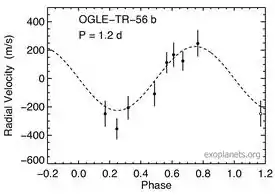 Size comparison of OGLE-TR-56b with Jupiter. | |
| Discovery | |
|---|---|
| Discovered by | Konacki et al.[1] |
| Discovery date | 3 November 2002 confirmed: 4 January 2003 |
| Transit | |
| Orbital characteristics | |
| Apastron | 0.0225 AU (3,370,000 km) |
| Periastron | 0.0225 AU (3,370,000 km) |
| 0.0225 ± 0.0004 AU (3,366,000 ± 60,000 km) | |
| Eccentricity | 0 |
| 1.211909 ± 0.000001 d 29.08582 h | |
Average orbital speed | 203 |
| Inclination | 78.8 ± 0.5 |
| Star | OGLE-TR-56 |
| Physical characteristics | |
Mean radius | 1.30 ± 0.05 RJ |
| Mass | 1.29 ± 0.12 MJ |
Mean density | 779 kg/m3 (1,313 lb/cu yd) |
| 19.8 m/s2 (65 ft/s2) 2.02 g | |
| Temperature | ~1973 |
OGLE-TR-56b is an extrasolar planet located approximately 1500 parsecs or 5000 light years away in the constellation of Sagittarius, orbiting the star OGLE-TR-56. This planet was the first known exoplanet to be discovered with the transit method. The object was discovered by the OGLE project, announced on July 5, 2002[2] and confirmed on January 4, 2003 by the Doppler technique.[3] The period of this confirmed planet was the shortest until the confirmed discovery of WASP-12b on April 1, 2008.[4] The short period and proximity of the OGLE-TR-56 b to its host mean it belongs to a class of objects known as hot Jupiters.

The planet is thought to be only 4 stellar radii from its star, and hot enough to have iron rain.[5]
See also
References
- ↑ Konacki, Maciej; et al. (2003). "An extrasolar planet that transits the disk of its parent star" (PDF). Nature. 421 (6922): 507–509. Bibcode:2003Natur.421..507K. doi:10.1038/nature01379. PMID 12556885. S2CID 1784939.
- ↑ Udalski, A.; et al. (2002). "The Optical Gravitational Lensing Experiment. Search for Planetary and Low-Luminosity Object Transits in the Galactic Disk. Results of 2001 Campaign - Supplement". Acta Astronomica. 52 (2): 115–128. arXiv:astro-ph/0207133. Bibcode:2002AcA....52..115U.
- ↑ Konacki, Maciej; et al. (2003). "High-Resolution Spectroscopic Follow-up of OGLE Planetary Transit Candidates in the Galactic Bulge: Two Possible Jupiter-Mass Planets and Two Blends". The Astrophysical Journal. 597 (2): 1076–1091. arXiv:astro-ph/0306542. Bibcode:2003ApJ...597.1076K. doi:10.1086/378561. S2CID 53610157.
- ↑ Hebb, L.; et al. (2009). "WASP-12b: THE HOTTEST TRANSITING EXTRASOLAR PLANET YET DISCOVERED". The Astrophysical Journal. 693 (2): 1920–1928. arXiv:0812.3240. Bibcode:2009ApJ...693.1920H. doi:10.1088/0004-637X/693/2/1920. S2CID 14526064.
- ↑ Harvard University and Smithsonian Institution (2003-01-08). "New World of Iron Rain". Astrobiology Magazine. Archived from the original on 2010-01-10. Retrieved 2010-01-25.
External links
![]() Media related to OGLE-TR-56 b at Wikimedia Commons
Media related to OGLE-TR-56 b at Wikimedia Commons
- "OGLE-TR-56 b". Exoplanets. Archived from the original on 2007-12-03. Retrieved 2010-01-21.